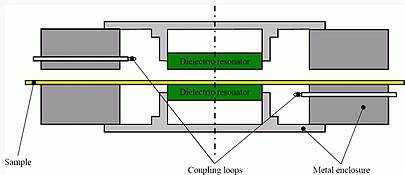Material Measurements
Resonance-Based Methods

Split-Post Dielectric Resonator (SPDR)
Split-Post Dielectric Resonators (SPDR) ensure a high precision and are suitable for dielectric measurements with low losses through the change of the resonance frequency and quality factor when they are empty (filled with air) and filled with a test material. An image of a cut of such a resonator is shown here. Both dielectrics (in green) allow the formation of the electromagnetic fields to be concentrated inside their radius and to be continuous in the separation of both resonator halves. For the measurement, the TE010 mode is used for the rotation symmetry of its electric field, which only has a Phi-Component.
Open Resonator
For the measurement of material properties in a higher frequency spectrum a so called 'Open Resonator' is available. A gaussian quasi-optical beam is formed with a concave mirror, which is later reflected by a planar mirror. The resulting standing wave is used for the measurement of flat samples placed on the planar mirror. Thanks to its high quality factor it is possible to measure a broad range of low losses materials.
Transmission-Line Methods
Different material properties can be measured out of the influence of a material in a transmission line. In dielectric-filled transmission lines, the substitution of a part of the dielectric (normally air) for a MUT ('Material Under Test') will change the conductive properties of it, which can be quantified thanks to its S-Parameters. Using numerical algorithms e.g. the Nicolson-Ross-Weiss algorithm, the dielectric constant of the MUT can be calculated from the S-Parameters, as well as its losses and the magnetic permeability (in the case of magnetic materials).
In those cases in which only the insertion loss of a dielectric or conductive material is of interest, this can be calculated comparing the transmission characteristic of a transmission line in two cases:
- when a part of its conductive element is substituted by a sample of the MUT (reference measurement)
- when a part of the whole transmission line (conductor and dielectric) is substituted by a sample of the MUT (load measurement)
This method is described for coaxial lines in the ASTM D4935-99 standard.

